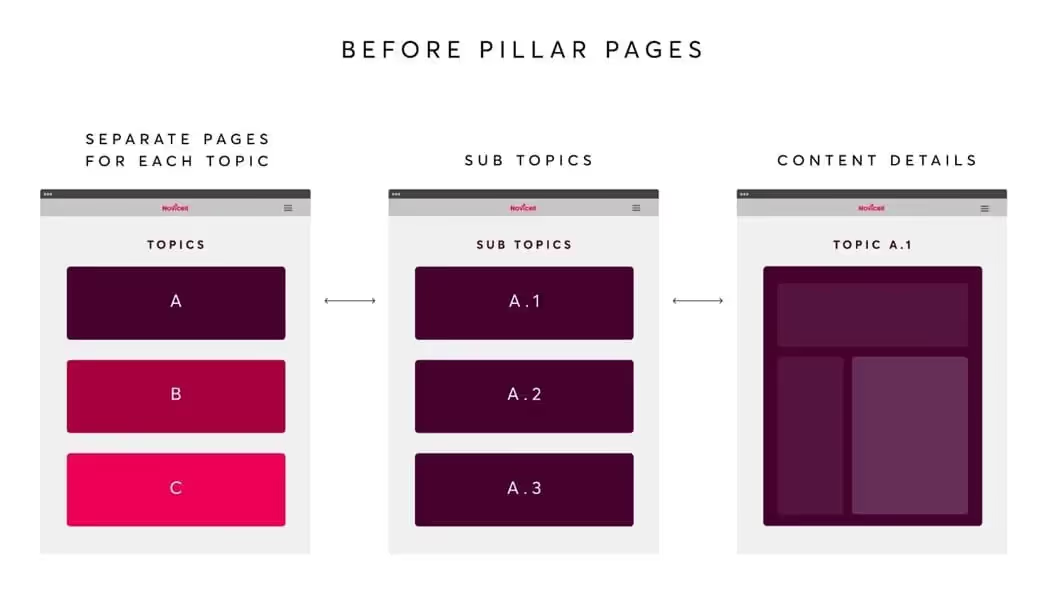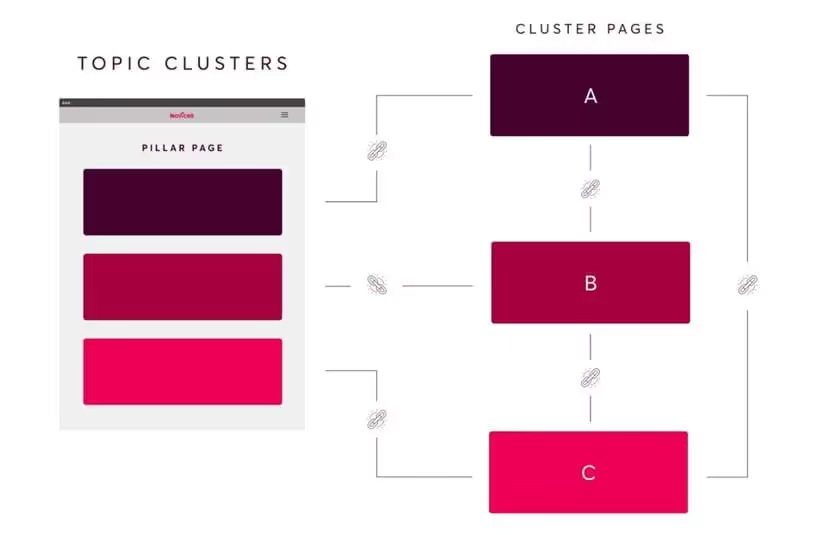Pillar pages: Why you should incorporate them into your strategy

If you want your content to rank first in Google and Increase traffic to your website to attract qualified leads, start creating pillar pages and content clusters. This will help you boost your strategy SEO.
The knowledge behind search engine algorithms is constantly evolving and, once again, there has been a change. It is no longer mainly a matter of selecting certain keywords to focus on the content, but rather of mapping topics or making a Topic Cluster, to achieve optimal positioning in search engine results.
A Google likes order and clarity, which is why creating pillar pages is a key technique. So to give you a better understanding of how this content organization strategy works, we explain what pillar pages are and Topic cluster.
What is a Pillar Page?
The pillar pages, as their name suggests, are thematic pillars within your content marketing strategy, which define the editorial calendar.
It is a page that contains the main content you want to stream. The pillar page describes the general details of the topic and is very comprehensive. Often, the content of this page is significantly longer than that of a recurring article, since it incorporates all the sub-topics that the main topic, for which you want to position your website, can present.
Since the pillar page has more content than usual, it might be a good idea to divide it into sections to make it easier to digest. It will be beneficial to add different headers and visual assets, such as videos and images. This way it will be more attractive content and will motivate user reading and interaction.

Keywords vs Topics
The way people use search engines has changed. Before, keywords did the job, but now people type in longer and more specific search queries to find the most relevant information.
For example, if you want to get a gym membership, most people will search for long keywords, also known as long-tail keywords, such as “Gym with yoga classes in Barcelona” instead of just “gym”.
Because of this, search engines have developed from interpreting individual keywords to understanding and connecting the meaning behind longer search queries.
This is how Google and other search engines try Read the mind of the user. For example, if you search for “body lotion”, Google will now also show you “face cream” to ensure you find exactly what you're looking for.
This is why businesses and bloggers should evaluate the way in which they create content to remain visible on the search engine results page (SERP). But where to start? We guide you through the process.
What is Content Cluster?
Content cluster or content cluster, refers to detailed pages on topics or subtopics mentioned on the pillar page. While the pillar page provides an overview and presents different concepts and areas related to the topic, the Content Cluster allows for greater depth and detail in each concept.
Therefore, it is also possible divide the pillar page into different sections, where each section links to a new article that delves into the specific area: the Content Cluster or content cluster.
You should note that, just as the pillar page links to the content cluster, the pages in the content cluster must be linked to the pillar page. Doing this makes it easier to navigate between them and the themes come together in the same thematic universe, thus creating a “topic cluster”.
What is a Topic Cluster?
Un Topic Cluster is a thematic group consisting of several pieces of content on the same topic. Instead of writing just one text on a certain topic, you'll create several related texts. The content can be in the form of blogs, articles, downloadables or any other resource that talks about the topic of the pillar page. As we have already mentioned, each of these pieces of content is called content cluster.
It is not necessary to write all the Content Cluster In one go. It can be an ongoing, long-term process. In fact, regular updates to existing pages are more recommended, as they show Google that your pages are up to date with the latest news on your topic.
There's no right answer as to how many pages of Content Cluster they must exist, since it depends on the depth of the topic. However, a useful rule is to have between 15 and 30 pieces of content related to each Topic Cluster.
Have we confused you? Don't worry! We will continue to answer your questions.

In short, the Topic Clusters It is made up of two elements:
- The main page or Pillar Page.
- Secondary content pages or Content Cluster that support the Pillar Page.
El Topic Cluster is based on the main page, which covers all aspects of the topic and is the central page. From there, the secondary content, which covers different sub-topics in depth, is linked to the pillar page via hyperlinks.
This link structure shows Google that you have extensive information on the topic, it also serves to provide relevant content and makes it easier for the reader to navigate, whether it's a quick summary on the main page or a detailed article in the secondary content.
In addition, it helps the algorithm to identify the Topic Clusters: When a page works well, Google rewards it and boosts the performance of the entire set of related content.
How to implement a Topic Cluster strategy?
When creating Topic Clusters, You change the focus from creating content by keywords to creating content by topic. This goes hand in hand with current user behavior with search engines.
To begin implementing this strategy, you must take the following steps:
- Decide on the main topic you want to position yourself for, related to your business or industry.
- Map out all the sub-topics that the main topic can offer.
- Create the pillar page, include a summary of each sub-topic so you can eventually link it to other content pages.
- Create secondary content based on keywords related to the main topic. The theme will help you choose your keywords more effectively.
📢 Be careful with keyword stuffing. This happens when you overload the content of a page with keywords, making the text difficult to understand, affecting your ranking in the SERP. Google will find out and penalize you for prioritizing positioning over valuable content.
This isn't a farewell to keywords, but rather an introduction to a new strategy for using them in your content.
Prioritize the monitoring of results
The truth is that you will need time, patience and effort to implement these structural changes on your website. For that reason, it's important to define your objectives and measure results.
Monitoring results is essential and the essential indicators are:
- Total page views.
- Time on the page.
- Bounce rate.
- Conversions.
In addition to Measure your pillar pages, you can also compare your different Topic Clusters to see which ones attract the most traffic and potential customers to your page.
Keep in mind that you won't see real results overnight, this may take a few months. If you want to speed up the process, consider promoting your homepage through paid advertising.
By monitoring the performance of your pillar page, you can continuously adjust and optimize your content to maximize SEO and capture quality leads. You can update pages that aren't working well, taking inspiration from the good practices of those that have succeeded.
What are the benefits of implementing a pillar page?
Being up to date with your SEO strategy is essential if you want your potential customers to find your business and services. Therefore, it is very important to know how to adapt to the new way users search. The use of Topic Cluster and the creation of pillar pages, will help you achieve the best possible position in search engines and increase traffic to your website.
Using this strategy allows you to provide clear and efficient answers to users, thus improving their experience on your website. In addition, you will make them stay longer on your page, since the pillar page has links that answer different searches in detail, which will lower the bounce rate.
The creation of a pillar page promotes your extensive knowledge and experience in a specific topic, which Demonstrate your authority on the subject. However, the most important thing is that creating a pillar page will boost your SEO performance.
Do you want to improve your SEO strategy?
Do not hesitate to put yourself in contact us, our experts will help you implement the best strategy.
Cómo podemos ayudarte
Consulta los servicios con los que te ayudaremos a conseguir tus objetivos digitales.
.avif)